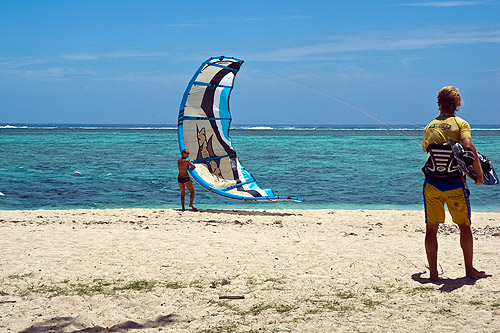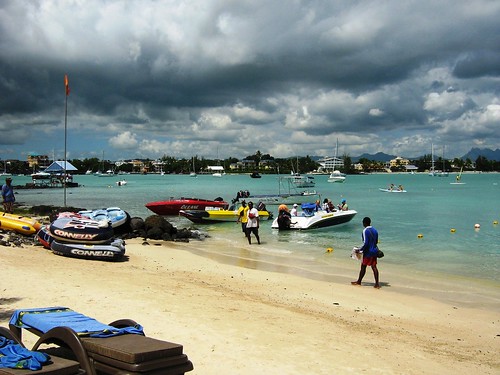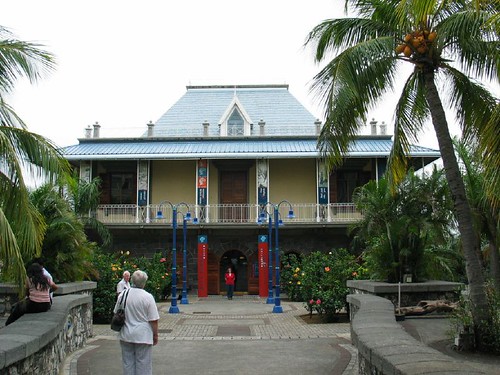
The wide beaches of the east coast are reserved for those seeking peace and quiet, away from the hustle and urban routine. The large hotels, which would slowly settle on the beaches, offer their customers a luxury service, so that nothing will ruin the perfect moment. Water sports and boat rides, surfing, kitesurfing, diving and rowing are among the activities offered by the island.
A 900 km east of Madagascar, washed by the waters of the Indian Ocean and protected by coral reefs, lies a paradise called Mauritius, which coexist Hindus, Muslims, Christians and Taoists. This combination of cultures results in a country where festivals, music, food and other art made of the identity of his people (peaceful, cheerful and outgoing) a secret challenge to discover: which is the result of a unique blend, represented in every corner of this small island paradise.
Luxury vacation is offered by Mauritius, with the best five star hotels, mainly concentrated in the north of the island, which has a highly developed commercial area, but in a peaceful and harmonious with nature, as the Most buildings are made of wood. The sands of its beaches, by far the most popular are white, thin, and its blue waters, calm and clear, is that most of the island is surrounded by a coral reef, which is also ideal for lovers diving (many hotels offer courses free of charge and provide basic equipment). Clown fish and damsels are some species that can be observed.
In the northern region is also Grand-Baie, known as the Mauritian Saint-Tropez, from the luxury of its shops, variety of gastronomy, where Chinese restaurants, Creole and French, among others, and its lively nightlife.

For those seeking a slightly quieter season, away from the main tourist centers. The east coast is the best destinations, especially from Port Louis (capital) to the south. Its beaches are still a paradise for those who usually enjoyed only in postcards from faraway places, with the bonus of being even larger than the north. Moreover, the waves (the Tamarin, Ilot Sanchot and One Eye particular) are among the most internationally renowned for surfing. However, it is the ideal place for fans, as waves break over the reef, to master and not end up injured, you must have extensive experience on the table.
For other extreme sports such as kitesurfing or windsurfing, the east coast is ideal, with winds circulating trade winds between the tropics where there are big gaps protected by barrier reefs. Here, urbanization is low, making it the best place for those wishing to escape from mass tourism (the region of Le Morne Brabant is recommended).

Port City:
Heading south, the landscape changes dramatically. Rocky shores alternate with vast beaches, interrupted several times by impressive volcanic cliffs. It is the ideal place to stay, but he can skip a visit: the sights, sounds and smells of turquoise waves pounding against the rocks are a mental picture that will remain forever etched in memory. In this part of the island, in the hills of Bois Chéri, is also the route of tea. Guided tours to the factory and the museum dedicated to that product, organized by several operators on the island. The Parque Nacional de la Rivière Noire is another attraction of the southernmost part of the island. Numerous birds that live here have become endemic to Mauritius, such as parrots, kestrels and orugueros, jealously guarded, especially given the history of what happened to the dodo, a bird the size of a turkey represented in the coat of the island extinct a few decades ago.
Toward the center of the island, the climate becomes much wetter and disappear hotel. Herein lies the most Mauritanians, protected by mountains and volcanic craters (inactive), including waterfalls and hidden rocks sculpted by water erosion. Going from the coast can be seen the sugar cane plantations, which occupy 90 per cent of arable land. Between March and September, the tall dominating the landscape, hiding the rocky peaks of the mountains.
So far, its natural attractions. But Mauritius is much more than white beaches, exotic fish and warm water (which is no small thing). Is that because its melting pot, each town or city has temples, museums, markets and other places pins.
Culture:
In the northwest lies Mauritius Port Louis, the capital and largest commercial pole, founded during the French colonization in the eighteenth century, when it was used as a naval base. Different images and paintings revive the distant decades of privateers, ships and light frigates, in addition to perpetuating the historic commercial buildings. Arriving at Central Market (open daily from 5.30 until 17.30 and on Sunday until 23 hours), an air of memories and possibilities dazzles the intention of those who had planned to save. Known by locals as «Big Bazaar», the accompanying aroma port loaded rows of crafts, vegetables and fruits, exotic spices. The site where they sell Indian medicinal herbs is one of the posts to arouse more curiosity among visitors, with a variety of remedies and treatments for virtually all types of ailments, from a bag tisiana slimming (3 euros), to solutions for impotence for less than 5 euros.

Another attraction that reveals the history of the city is the Blue Penny Museum, which runs throughout the history of Mauritius. It saved two of the most expensive postage stamps and old the world: the Two Pence Blue and Orange Penny. Also, the Sugar Museum, built in 1842 as a result of the privileged place had this crop in the colonial period. Here we recall their method of manufacture, its unique cane, and its unique flavor. To rest after hours of walking and not overlook the lunch, it’s worth going through the restaurant Le Fangourin.
A few steps south stands the Cathedral of St. Louis (Sir William Newton Street), built in 1850, and St. James Cathedral (Poudrière Street), 1932, both of worship for Christian believers, numbering approximately third of the total population. The rest of the villagers raise their prayers in different ways. Peaceful coexistence between Hindus, Muslims, Christians and Taoists, represented in four colors of their national flag (red, yellow, blue and green) forms the idiosyncrasies of the island and is the perfect reference to respect for religious diversity.
If you remember the days of conquest, understand the multicultural nature of its own people. On the one hand, we know that the earth was the object of desire of Portuguese, Dutchmen, French and finally English, who remained there until 1968, when independence was declared. Slavery, in turn, contributed to shaping the ethnic geography of the place. Do not forget that many Africans, mostly from neighboring Madagascar, settled in Mauritius, taking their primitive rituals. Some time later, colonialism became interested in Chinese, Tamil and Hindu, and introduced them as cheap labor.

The temples are the insignia of each of these four religions. They deserve the attention of anyone wishing to delve into the beliefs and traditions that hold these beliefs. At the heart of the capital, draws attention, erect and stately, the largest Muslim shrine on the island: Jummah Mosque. In the neighboring town of Sainte-Croix is the Tamil Temple, the most important of the region (of Indian origin), known for its yellow facade, pink and green, and floral shrine. Way south, along the Grand Bassin lake, the Indians found a place of worship and sacred properties, which tend to deliver their prayers and offerings. Facing the lake, built the temple that bears his name, to strengthen ties between community rituals and prayers. The mirror sits settlement north of the island, in the church Cap Malheureux ( «Cape of misfortune»), a tribute to the many shipwrecks in the area.
So ends our tour of Mauritius…
Leave a Reply
You must be logged in to post a comment.
Recent Comments